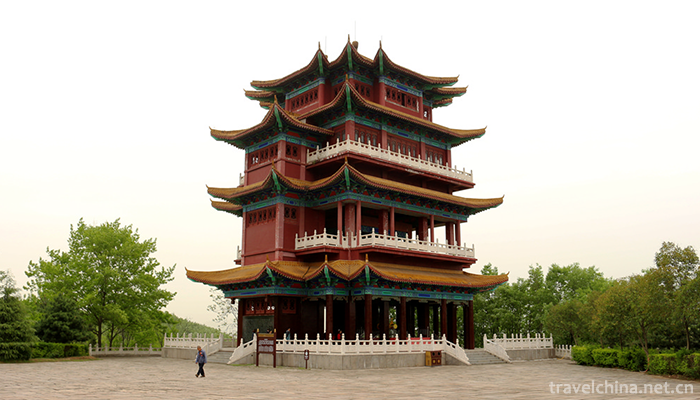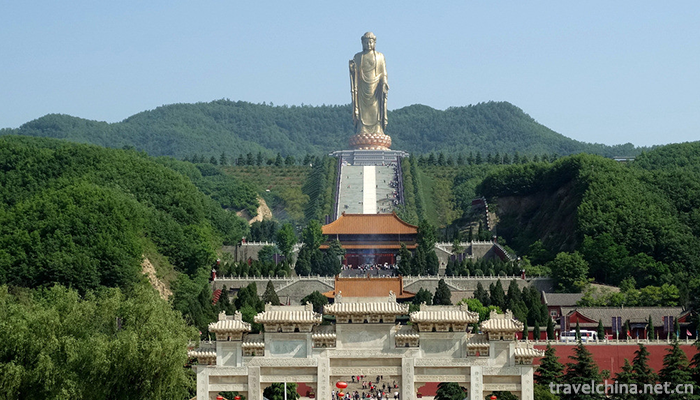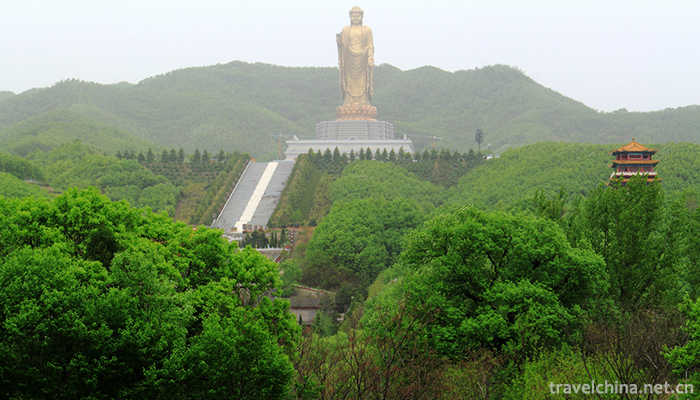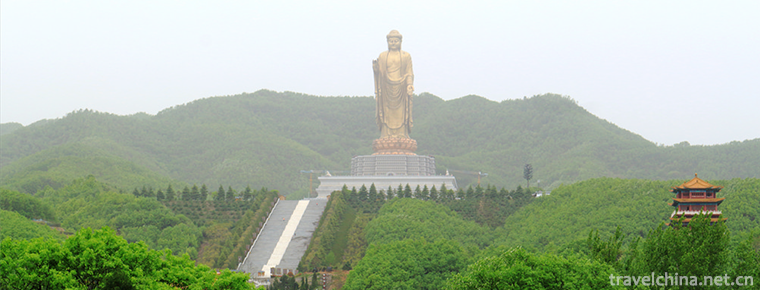Zhongyuan Great Buddha Scenic Area
The Central Plains Buddha, located in Shangtang Foquan Temple, Zhaocun Township, Lushan County, Pingdingshan City, Henan Province, is the highest Buddhist statue in the world. It was designed and manufactured in 1997 by Putian Xingsheng Craft, the inheritor of national intangible cultural heritage and the vice president of Fujian Arts and Crafts Masters Association Lin Shengbiao . The Buddha is 208 meters tall, 108 meters tall, the lotus pedestal is 20 meters tall, the Vajra pedestal is 25 meters tall and the Xumi pedestal is 55 meters tall.
Tianrui Auspicious Golden Bell in the scenic area weighs 116 tons net. It is the "world's largest external strike bronze bell" recorded in the Guinness Book of World Records. In 2011, the Grand Buddha Scenic Area in Central Plains was listed as a national 5A-level tourist attraction.
The 208-meter-high Central Plains Buddha stands on the land of Central Plains, surrounded by the Jade Pillow Mountains, gazing compassionately at all living beings, perfecting the Buddhist philosophy of "Five Squares and Five Buddhas". It is reported that the construction of the Great Buddha has gone through ten years and experienced many setbacks. Finally, with the cordial care of governments and leaders at all levels and the enthusiastic help of many Buddhists, on September 29, 2008 (the first day of September in the Lunar New Year), 108 eminent monks from four places across the Taiwan Strait, including China, came into being. The president of Buddhist Association, such as Yicheng elder, the founding patriarch of Foguangshan Mountain in Taiwan, Master Xingyun, President of Hong Kong Buddhist Federation, Chueh Kwang elder, and so on, has many Buddhists from Japan, Australia, Korea, France, India, Taiwan and other countries and regions who have traveled thousands of miles to worship the Buddha.
Bodhisattva Man Jingling Mountain Foquan Temple Central Plains Buddha
(author: Zhai Hong Ben)
Liantai moved its seat to Yaoshan.
The spirit of Buddhism changes today.
Because of the soup,
More cloud side.
Sing the Golden Bell and sing far away.
To solve the misfortune of Zhao people.
He visited thousands of mountains.
It is good to have good luck.
Bell is a kind of musical instrument in Chinese traditional culture. It is also a necessary instrument in temples and temples. The bell sounds melodiously every morning, which symbolizes peace and auspiciousness. So the bell is also called auspicious bell. This clock is funded by Tianrui Group Company and cast by Tianrui Foundry Company. Therefore, it is named Tianrui Auspicious Bell. The big bell began to be cast in June 2000. It was completed on December 28 of the same year. It rings here at 0:00 on New Year's Day in 2001, marking our entry into the 21st century, so it is also called "Century Bell". Tianrui auspicious bell weighs 116 tons, is 8.108 meters high, its maximum diameter is 5.118 meters, and its thickness is more than 20 centimeters. It is the largest and heaviest external striking bronze bell in the world. It was appraised by experts in 2002 and obtained the certificate of Guinness World Records Certification. Dazhong inherits the excellent tradition of the Chinese nation, embodies the characteristics of the times and has rich cultural connotations. At the top of the bell is a double-headed Kirin bell button. Legend has it that he is the third son of the Dragon King, named Pulao. Because of his natural love and roar, he is often set as an ornament on the button, the wall of the bell and many Buddhist buildings. The shoulder part of the bell is composed of 36 golden vines and lotus flowers, which are pure magic instruments. It is also a symbol of holiness loved by celebrities of all dynasties. The upper part of the bell is composed of four auspicious cases, namely, Jinlong Opera Pearl, Danfeng Chaoyang, Xianghe Dancing and Ruilin Tengyun, which symbolize wealth, peace and auspiciousness respectively. Between the upper and lower parts of the palace are four inscriptions of Zhong Ding inscriptions, totaling 666 words, which record the origin, function and the famous bells of all dynasties. The waist part of the bell is composed of 56 Ruyi cases, which symbolizes the close unity of our 56 nationalities and the sharing of good luck. It is a blessing to the construction of our socialist motherland for a thousand miles and never stops. Bell skirts are carved with pictures of mountains, rivers, suns, moons and auspicious clouds, which symbolize a magnificent mountain and river of our great motherland. There are two couplets inscribed on the East and west sides of the bell wall. To the east, there are "Nafu Zenghui, good weather" and to the west, there are "eternal preservation and national peace". In addition to the world's heaviest external impact bronze bell, this big clock has a very important feature. It is cast on site and formed at one time.
The Grand Buddha Scenic Area of Central Plains is located 50 kilometers west of Lushan County, the terminal of Zhengzhou-Yaoshan Expressway, and the junction of 311 National Highway. The scenic area has convenient transportation, surrounded by mountains, beautiful mountains and rivers, beautiful environment, human landscape and natural landscape. It has the world's first Buddha, the first bell, the first soup in the mainland, the first temple in Funiushan Mountains and so on. Tourism cultural resources are a tourist attraction integrating Buddhist culture, warm bath, Liaoyang, sightseeing, leisure and entertainment. They are the leading scenic spots of ecological tourism in Funiu Mountain, Henan Province. After more than 10 years of construction, the scenic spot has begun to take shape, and its popularity has gradually improved. It has become an important tourist attraction in Southwest Henan. Scenic spots include archways, Foquan Temple, Wishing Platform, Fuhui Avenue, Lifo Platform, Central Plains Buddha, Tianrui auspicious bell, Buddhist cultural palace, cultural monument gallery and other scenic spots, as well as supporting service facilities.
At the end of 2007, the "Zheng-Yao Expressway" (Zheng-Shi Expressway) from Lushan to Zhengzhou runs through the whole line, with the Big Buddha's foot as the terminal point and convenient transportation.
At 9:59 a.m. on September 29, 2008, 108 eminent monks gathered at Foquan Temple in Lushan, Henan Province, four places on both sides of the Taiwan Strait, to open the light for the Great Buddha of the Central Plains and pray for national peace. There are many Buddhists from Japan, Australia, Korea, France, India, Taiwan and other countries and regions present, such as the President of the Chinese Buddhist Association, Mr. Yicheng, Master Xingyun, the Kaishan patriarch of Foguangshan Mountains in Taiwan, and the President of the Hong Kong Buddhist Federation, Mr. Chueh Kwang. In 2011, the National Tourist Scenic Spot Quality Grading Committee approved Yaoshan-Zhongyuan Grand Buddha Scenic Spot as "National 5A Tourist Scenic Spot".
At the Boao Summit of World Tourism Elite, held at the Boao Forum for Asia, Lushan Grand Buddha Scenic Spot was awarded the "International Ace Tourist Spot" and accepted as a platinum member by the International Tourism Marketing Association. After the completion of the second phase project of Lushan Grand Buddha Scenic Area, which invested 1.26 billion yuan, it will become an international first-class hot spring resort and a holy place of Buddhist culture in the world, integrating Buddhist worship and praying, hot spring recuperation, leisure vacation and tourism.
Impression of Buddha
"Pingdingshan People's Congress" No. 2013.5 Wenyuan column article
Leading Ciyun to raise the sky,
King Kong begets Ruilian.
Hengyu Pillow in Liushi Temple of Castle Peak,
Green water ritual Buddha Jibitan.
The Chan Chamber has long been a continuation of Tang Mi.
The East Tower Evening Bell dates back to the Yuan Dynasty.
Ten Fangjian people crossed Fuquan.
The Tathagata laughs at the wishes of all living beings.
At the beginning of the construction of the Great Buddha, Muming went to the construction site, busy and messy. Buddha, surrounded by scaffolding, green gauze fence, hard to see the true face, and then disappointed. For this reason, since the completion of the Buddha, although less than a hundred miles from the Buddha to and fro, there are several passes, and no parking. In the early autumn of last year, friends returned home from other places, just in time to relax and make an appointment to visit Buddha Rong. Ten miles away, the peak turns back and the Buddha's body disappears from time to time, often thinking that the Buddha is in front of the mountain, but there are more front hills in front of the mountain, so repeatedly, inadvertently, but already before the Buddha. When facing this situation, instantly convinced: the blue sky, white clouds and green hills are the curtain, a golden Buddha is shining brightly, standing in front of us, the first one is auspicious clouds, high-spirited sky; Buddha, with a strict face, quiet and smiling, seems to reveal a slight hiding, showing all kinds of kindness, Ruilian is born on the seven-tier Vajra throne, Buddha feet trample lightly, like stepping on clouds. The Jade Pillow Mountain, as its name implies, is green and looks like a jadeite pillow. It leads Buddha in front and lies in the heart of the temple. The sandy river winding up to it, ripples with beautiful water, strives to see the Buddha's face, and the ritual Buddha does not go, crowding into a curved green pool. The Chan Chamber has a long and powerful sutra, which goes deep into the heart. It shows that this sacred place in ancient times is actually a sectarian Taoist temple. The bell tower sounds late, distant and difficult, and the sky is vast. It shuts its eyes with its breath and goes back to the Tang Dynasty like a dream. See you again the grand occasion of Buddhist Spring Temple in the first year of Kaiyuan. Ten believers, friends from all over the world, or because of Buddhist Dharma, or concern, or for leisure, gathered here, bathed in the holy water of Tangquan, cleansed up the dust, prayed for Buddha and blessed Buddha; the Daily Tathagata came to realize the world, see the heavens, see the heavens, kindness knot, laugh to meet the ten pilgrimages, delicate appearance, as if to grant the wishes of the masses.
Pingdingshan Buddha
See all the wonders of magic, turn right to see Pingdingshan;
The Dharma is boundless, and the heavens and the earth go hand in hand towards the Central Plains.
Buddha Spring Temple
Foquan Temple was built in Zhenguan period of Tang Dynasty (Xuanzong period). It has a history of more than 1300 years. According to legend, in the early years of Zhenguan, Taizong of Tang Dynasty had a dream at night. He saw the Buddha standing under Yuzhi Mountain in Zhongzhou, sprinkling manna and dew to all living beings in Po'e Tangchi. He was shocked by the earthquake. He knew that the Buddha had ordered people to search for the land in Central Plains by drawing pictures according to dreams. From the west of Lushan County, we went down to the soup, entered the middle soup, and found the disordered soup (Shang Tang). The terrain we saw matched the map, and we were overjoyed. Hot springs erupt all the year round on the South Bank of the Siqian Sha River. The water quality is excellent, the water temperature is suitable, the water is rich in minerals, good at treating all kinds of diseases, known as "Foquan". Hebei Mountain is vigorous and purple, that is, to build temples in front of the mountain. The temple is named after the spring.
Foquan Temple has experienced several times of ups and downs. Now it has been restored to Babao, Shanmen, Tianwang Palace and Daxiong Palace.
There are eight white jade sculptures in Babao Square in front of the temple. They are called Buddha Babao. They are wheel, snail, umbrella, cover, flower, pot, fish and eight Buddhist objects. Its meaning is:
Falun: There are two sentences in Buddhism: "Great Falun turns round and goes on forever". Therefore, these two sentences will be attached to the wheel, called the Falun, listed as the first eight treasures.
Fa Luo: Conch is a musical instrument played by ancient India. It can transmit wonderful sounds. In Buddhist sutras, there are two sentences: Bodhisattva-like and good-luck. So the conch is called Faluo, ranked second in Babao.
Umbrella: Umbrella can shelter the sun from the rain. There are two sentences in Buddhist sutra: "cover three thousand, clean all occupations". Umbrella ranks third in Babao.
Baigai: There are two Sutras in the Buddhist Sutra: the Great White Umbrella Cover Sutra and the two Sutras of "relaxing freely and compounding all living beings". Therefore, it is called Baigai and ranked fourth in the Eight Treasures.
Lotus: In our country, it is described as "not stained by sludge". In ancient India, there is a similar saying. There are two sentences in the Buddhist Sutra, which are "out of the dirty world, out of the dye", so lotus flower is listed as the fifth of eight treasures.
Pot: Ancient Indians used large water cans to draw water and put it on their heads. There are two sentences in the Buddhist Sutra: "Buddha's wisdom is perfect and there is no leakage". Therefore, they called the water cans treasure cans, ranking sixth in the Eight Treasures.
Goldfish: Gold is not afraid of fire. Fish are lively. They are made into a pair of fish with gold. They are strong and lively. The implication is never bad. They correspond to the two sentences of "strong and lively, free from evil" in Buddhist sutras. Therefore, goldfish is listed as the seventh of Babao.
Panchang: also known as Panchang, is a long circular ornament, is one of the ancient Indian patterns. It corresponds to the two sentences in the Buddhist sutra, "implement the cycle and make everything clear", and ranks eighth in the Eight Treasures.
Buddha Babao has obvious religious significance. It is generally used in Buddhist architecture, but not in other buildings.
Abbot of temples
Master Shi Yanfo, commonly known as Shang Lianfu, was born in Dengfeng City, Henan Province in 1942. When he was in his prime, he was disabled on business and paralyzed in his lower limbs. From then on, he suffered from the cold and humiliation of the world and almost wanted to break away from fate. His mother, Hou Shi, was a great woman who, with the love of his mother and his earnest teaching, eventually made Lianfu realize the true meaning of life, vowed to convert to Buddhism and practise meditation.
With his mother's companionship and care, Lian Fushi took the Bodhisattva's statue to the Songshan Mountains and fled to the Red Dust. He successively practiced in Junji Palace, Old Mother's Cave, Anyang Palace, Daxian Cave, Liangliang Temple, Qinghui Palace and Lianhua Temple. After seven disasters and eight hardships, he finally achieved the Bodhi fruit. In 1983, he was accepted as a closed disciple by Yongshan monk of Shaolin Temple, who gave the Buddha the name of Buddha. In 1987, Shiyan Buddha led six disciples to the Dafawang Temple in Songshan, one of the earliest Bodhisattva Taoist temples in China, at the command of the Shaolin Monastery's chief administrative monk, and shouldered the historic task of revitalizing the Dafawang Temple in Songshan, one of the earliest Bodhisattva Taoist temples in China. With perseverance, the spirit of moving mountains and Buddha's Zen enlightenment, after more than 20 years, he has overcome many difficulties, spread kindness, popularized all living beings, won the support of the Eight Parties, did not want a penny from the state, a disabled monk never disgraced his mission, raised more than 120 million yuan from his own fund, and rebuilt an abandoned temple into a six-chamber seven-entrance. The magnificent scale and magnificent momentum have resounded throughout the famous temples at home and abroad.
Shi Yanfo often recalled the dream of the old mother's cave in Songshan Mountain when he was at the Great Fawang Temple in Zhongxing. He was haunted by it: "He stood looking around Songshan Mountain and saw a golden Buddha standing in the mountains with dew and grace in his face." The slogan: "Xiao Xiao'an, Xixi" is delicate and waiting for something. Shi Yan Buddha could not sleep at night. He pondered over and realized, "As empty as possible, Buddha stood among the mountains of the Central Plains, but this small mountain has immeasurable creations. My generation should invite Buddha to live in tin and worship the land of Zhongzhou, let Buddha light bathe in a thousand, and make the three realms plump and sweet dew." From then on, the great wish of creating Zhongtian Buddha was always agitated in his chest, and an irresistible sense of mission was deeply rooted in his heart.
Under the guidance and support of Mr. Zhao Puchu, President of the Chinese Buddhist Association, Shi Yanfo has embarked on a long and arduous road of creation since 1990, with his disability as his body. He was determined to create the world's largest Buddhist icon project, leaving a valuable cultural heritage lasting for thousands of years for mankind, and more importantly, to let people's beliefs survive with the Buddhist lineage. It is the way of heaven that rewards diligence and achieves things with ambition. Shi Yan Buddha has been traveling for several years. He has gone through many hardships and earnest sincerity. All the ten Buddhas in the world have been added to his work. With the support of Tianrui Group, in 2002, he finally started the magnificent project of creating the Great Buddha. It took five years and cost 280 million RMB. In 2007, the Central Plains Buddha was finally built and completed. The Buddha statue was solemn and peaceful, with great momentum, standing tall in Zhongzhou, and the Buddha's light was shining all over the world.
tourist resources
Hot spring, hotel, Shangtang hot spring scenic spot is located in the south of Henan Province, south foot of Funiu Mountain, 10 kilometers west of Lushan County, Pingdingshan City. The unique hot springs, beautiful natural scenery and shocking Buddha and other high-quality tourism resources in the scenic area make the scenic area have good prospects for development. Two five-star platinum hotels are being built in the scenic spot, which integrate tourism, accommodation, conference and Spa recuperation. At the same time, golf courses, airports and other projects and services are being planned.
Traffic guide
Self-driving route from Zhengzhou to the Grand Buddha Scenic Area of Central Plains:
Zhengzhou Songshan South Road South Four Rings Shangzheng-Yao Expressway Getting off at Yaoshan Exit Along Yaoshan Direction Driving according to Yaoshan Scenic Area Sign Central Plains Grand Buddha Scenic Area
Self-driving routes from Luoyang, Nanyang, Jiaozuo, Jiyuan, Sanmenxia to the Grand Buddha Scenic Area of the Central Plains:
Shang-Er-Guang Expressway goes along Nanyang and Xiangfan directions (Zhengnan)Xiatang Station to Zheng-Yao Expressway (along Yaoshan direction) to Yaoshan Exit_according to Yaoshan Scenic Area Sign_Zhongyuan Grand Buddha Scenic Area.
Self-driving routes from Anyang, Puyang, Xinxiang, Hebi to the Grand Buddha Scenic Area of the Central Plains:
Beijing-Zhuhai Expressway to Luohe Nanluo Expressway Pingdingshan Shanxi to Zhengyao Expressway Yaoshan Exit According to Yaoshan Scenic Area Indicator Zhongyuan Grand Buddha Scenic Area
Shaanxi Province's self-driving route to the Grand Buddha Scenic Area in the Central Plains:
Lianhuo Expressway Luoyang-Guangzhou Expressway Pingdingshan-Zheng-Yao Expressway Yaoshan Exit Driving according to Yaoshan Scenic Area Sign Central Plains Grand Buddha Scenic Area.
The self-driving route from Shanxi Province to the Grand Buddha Scenic Area in the Central Plains:
The Shang-Er-Guang Expressway runs along Nanyang and Xiangfan directions (Zhengnan)Xia-Tang Station to Zheng-Yao Expressway_along Yaoshan direction_to Yaoshan exit_according to Yaoshan scenic spot sign_Zhongyuan Grand Buddhist scenic spot.





-
3.Zhou Enlais Hometown Scenic Spot
Zhou Enlai's hometown scenic spot is located in Huai'an City, Jiangsu Province, a famous historical and cultural city in China. It is a national 5A-level tourist attraction.
Time 2018-12-06 -
4.Funiu Mountain Skiing Resort
Located on the north slope of the old boundary ridge of Funiu Mountain in Luanchuan County, Luoyang Funiu Mountain Skiing Resort has the highest elevation of 2200 meters and an elevation of 1700 meter
Time 2018-12-22 -
5.Laiwu Campaign Memorial
Laiwu Campaign Memorial Hall is situated on the Huangshan Mountain in Laiwu District, Jinan City. It covers an area of 45,000 square meters and has a building area of more than 8,000 square meters
Time 2019-01-29 -
6.Anshun land Opera
Anshun Dixi Opera, a local traditional drama in Anshun City, Guizhou Province, is one of the national intangible cultural heritage.
Time 2019-04-01 -
7.Lantern show
Lantern Opera is not only a traditional folk opera with local characteristics in Chongqing and Sichuan, but also one of the important voices of Sichuan Opera. It originates from northeast Sichuan
Time 2019-04-26 -
8.Foshan Wood Engraving New Year Pictures
Foshan woodcut New Year's picture is a famous folk New Year's picture in South China and a wonderful flower of Lingnan traditional folk culture. It is as famous as the New Year
Time 2019-04-29 -
9.Brewing Techniques of Sufu
Sufu brewing technology, the traditional technology of Haidian District, Beijing, is one of the national intangible cultural heritage.
Time 2019-04-30 -
10.Five Palace Tunes in Haizhou
Haizhou Five Palace Tunes is a traditional folk music with a long history. It is an important link of Ming and Qing folk songs in Jiangsu Province. It is a precious relic of ancient "Zhugong Tune
Time 2019-05-02 -
11.Hydrology of Neijiang River
Tuojiang River is the main river in the urban area. It flows through Zizhong, Dongxing and Shizhong District. It is the main waterway transportation route in the city. Since ancient times, there has been a busy scene description of "boats of ten thousand trees
Time 2020-12-16 -
12.Nanchong Sports
By the end of 2019, Nanchong has 37 national youth sports clubs, 5 new national fitness routes and 1623 national fitness routes. Our athletes won 67 medals in national competitions and 288 in provincial competitions.
Time 2020-12-17